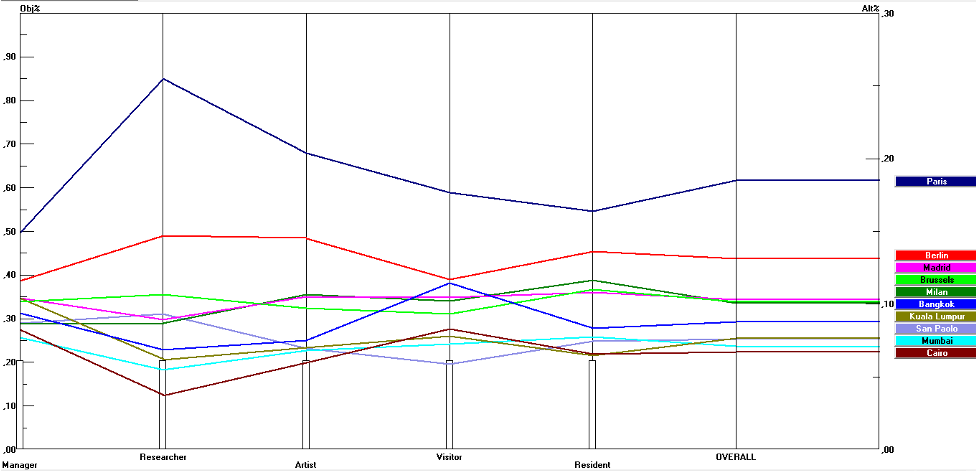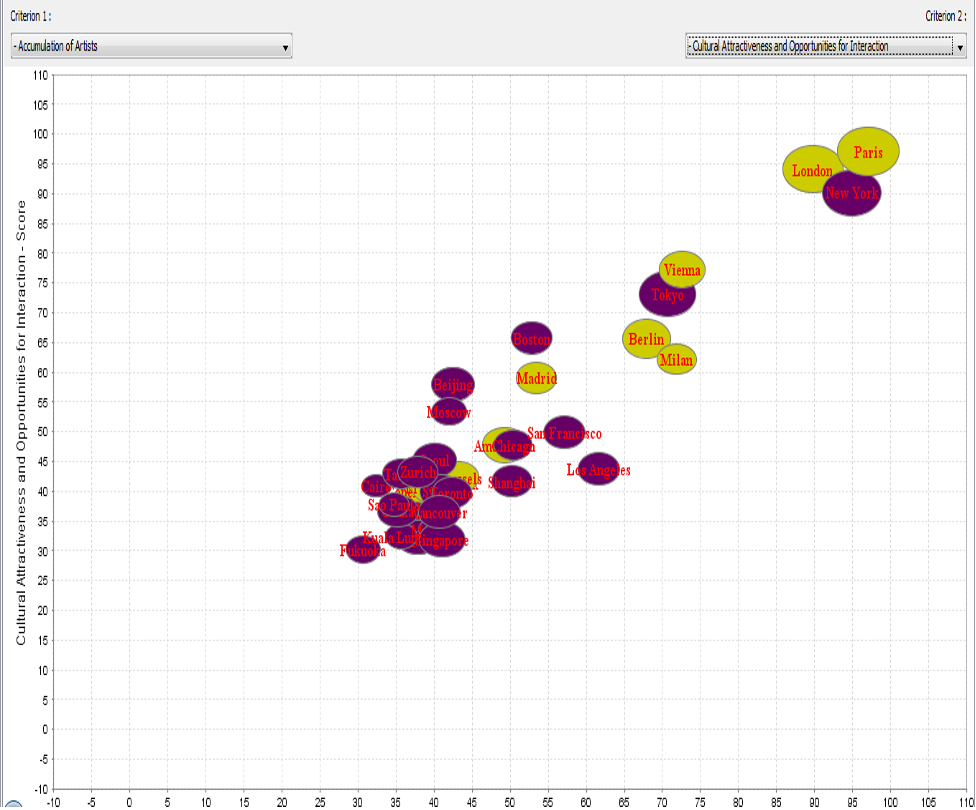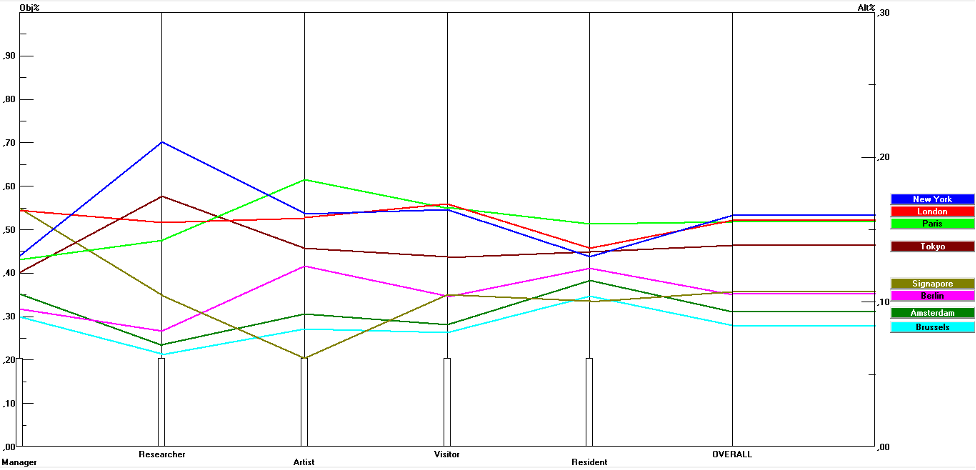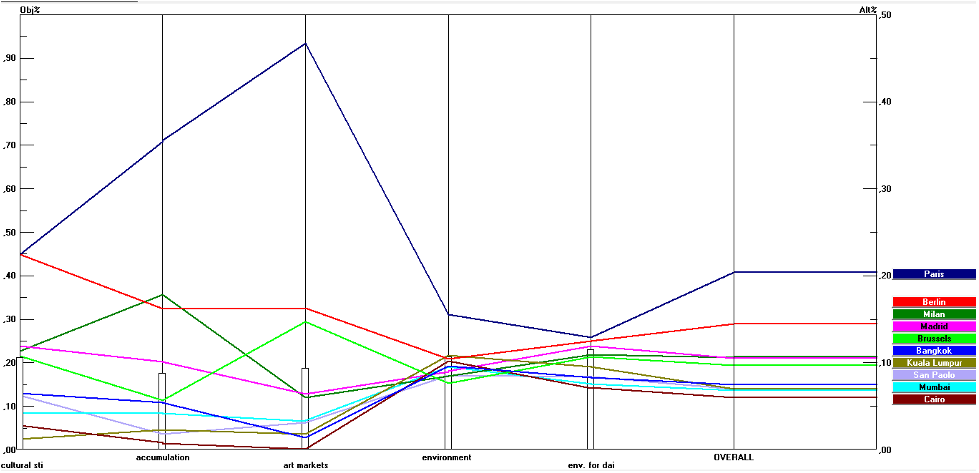
TI 2013-108/VIII
Tinbergen Institute Discussion Paper
A Multi-Actor Multi-Criteria Analysis of
the Performance of Global Cities
Karima Kourtit
1
Cathy Macharis
2
Peter Nijkamp
1,3
1
Faculty of Economics and Business Administration, VU University Amsterdam, The
Netherlands;
2
Vrije Universiteit Brussels, Belgium, and University of Gothenburg, Gothenburg, Sweden;
3
Tinbergen Institute, The Netherlands,

Tinbergen Institute is the graduate school and research institute in economics of Erasmus University
Rotterdam, the University of Amsterdam and VU University Amsterdam.
More TI discussion papers can be downloaded at http://www.tinbergen.nl
Tinbergen Institute has two locations:
Tinbergen Institute Amsterdam
Gustav Mahlerplein 117
1082 MS Amsterdam
The Netherlands
Tel.: +31(0)20 525 1600
Tinbergen Institute Rotterdam
Burg. Oudlaan 50
3062 PA Rotterdam
The Netherlands
Tel.: +31(0)10 408 8900
Fax: +31(0)10 408 9031
Duisenberg school of finance is a collaboration of the Dutch financial sector and universities, with the
ambition to support innovative research and offer top quality academic education in core areas of
finance.
DSF research papers can be downloaded at: http://www.dsf.nl/
Duisenberg school of finance
Gustav Mahlerplein 117
1082 MS Amsterdam
The Netherlands
Tel.: +31(0)20 525 8579

11 juli 2013
A Multi-Actor Multi-Criteria Analysis
of the Performance of Global Cities
Karima Kourtit
Dept. of Spatial Economics
VU University Amsterdam
k.kourtit@vu.nl
Cathy Macharis
Dept. Transport and Logistics
Vrije Universiteit Brussels
University of Gotheborg
Cathy.Macharis@vub.ac.be
Peter Nijkamp*
Dept. of Spatial Economics
VU University Amsterdam
A. Mickiewicz University Poznan
p.nijkamp@vu.nl
Abstract
The strong world-wide urbanisation trend calls for a repositioning of cities, especially the large
cities with a global impact. These cities tend to become economic, logistic and political
powerhouses and are increasingly involved in a competition on their integral performance. The
present paper aims to trace to what extent and why some cities outperform others. Starting from
an extensive database on many important characteristics of global cities, this paper offers a
multi-criteria methodology for identifying the relative position of various important cities on the
basis of distinct assessment criteria. The explicit consideration of the perceptions of important
classes of stakeholders on the performance outcomes of the various cities involved allows for a
enhanced policy analysis. From a technical assessment perspective, the applied part of the paper
employs the MAMCA and PROMETHEE multi-criteria methodology, which have proven their
analytical power in various multi-criteria evaluation problems over the past years. The paper
concludes with some policy perspectives and lessons.
Keywords: Urbanisation, global cities, multi-criteria analysis, performance, stakeholders,
MAMCA, PROMETHEE, GAIA
* Tinbergen Institute, The Netherlands
Pn585kkmc

1
1. Aims and Scope
In our urban century the majority of the people on our planet will live in cities. Urban
agglomerations tend to become the ultimate ‘destiny’ of mankind, with unforeseen challenges for
urban research and policy. In the ‘new urban world’(see Kourtit and Nijkamp 2013) dominated
by connected large cities and urban networks, our society will face serious concerns related to
housing, sustainable modes of living, poverty, employment, accessibility, competitiveness, and
economic vitality.
World-wide, cities are increasingly seen as engines of economic growth and sustainable
development (see Nijkamp 2008). This strategic importance of modern cities – and increasingly,
urban agglomerations and metropolitan areas including polynuclear or satellite areas – does not
only depend on location advantages (including Marshall-Arrow-Romer (MAR) spatial
externalities), but also on two other types of externalities, viz. social capital externalities and
connectivity externalities. The first category has been well described by Jacobs (1969) who has
introduced the concept of an urban ‘melting pot’: cities house a multiplicity of people with
different cultural, ethnic or language backgrounds which may at times create tensions, but also
form the seedbed conditions for innovative and creative behaviour (see e.g. Florida 2002). The
second type of externalities is based on economies of connectivity – either physical connectivity
through e.g. road or airline networks or virtual connectivity through global information or
internet networks (see e.g. Taylor 2004, Tranos and Nijkamp 2013).
The changing scene of cities – from an island position to a nodal position in global
networks – has brought about a series of challenges and concerns on cities of the future (see e.g.
Blanke and Smith 1999, Hall 2004, Jacobs 2012). According to Nanetti (2012), a strategic vision
of future cities calls for the following traits in urban development: territorially-specific, future-
oriented, problem-solving, strategically-informed, operationally-translated and politically-
committed. There is indeed a need for a strategic perspective on ‘sustainable urbanism’ (see
Diappi 2012, Farr 2008, Healey 2007), in which urban gentrification, culture, creative land use,
accessibility and ecological sustainability play a central role.
Clearly, the specific favourable facilities and social capital conditions of modern cities tend
to induce more creativity and profitability. A spatial concentration of activities, involving spatial
and social proximity, increases the opportunities for interaction and knowledge transfer, while
the resulting spillover effects reduce the cost of obtaining and processing knowledge. In addition,
knowledge workers preferably interact with each other in agglomerated environments so as to
reduce interaction costs, while they are more productive in such environments. It is therefore, no
wonder that cities become the cradle of new and innovative industries. Innovative firms based on
advanced services in the early stages of the product and company life cycle - when dealing with

2
a manifold uncertainty - prefer locations where new and specialized knowledge is abundantly
available at low costs (see e.g. Audretsch 1998, Camagni 1991). Cities offer in this context an
enormously rich potential for a wide array of innovative business opportunities.
Another major megatrend in human settlement patterns is noteworthy in this context, viz. a
structural rise in urbanisation in the past centuries. Our world has turned into an urban world,
with more than half of the world population living in cities nowadays (see also Kourtit et al.
2012). And the urbanisation degree is still on a rising edge, notably in Latin America, Africa and
Asia. This megatrend does not only mean a quantitative change in the share of inhabitants in
urban areas in the national territory, but also a qualitative transformation of both a socio-
economic and political nature. Modern network cities have turned into spearheads of (supra-
)regional and (supra-)national power, not only from a socio-economic perspective (business,
innovativeness, jobs, wealth), but also from a geo-political (‘cities as global command and
control centres’; see Sassen 1991) and a technological perspective.
To meet a wide array of future challenges and opportunities, urban agglomerations and
their business operations have to be smart and resilient. And therefore, over the years modern
global cities have dramatically changed the way of managing dynamics in urban development in
order to become and remain an attractive environment for various stakeholders, for example, in
attracting and retaining firms or tourists and in recruiting talented people in a vibrant urban
environment. To that end, appropriate support systems for a creative business environment need
to be developed, and more resources for sustainable growth need to be provided. Repositioning
of modern global cities calls for a solid evidence-based benchmarking analysis (see Begg 1999).
A major question is now: which are the critical parameters that may serve as policy handles
for a successful urban development? The road towards economic growth, social inclusion and
environmental sustainability of a city is not easy to achieve. In recent years, the concept of a
‘smart city’ has gained increasing popularity and has prompted a great deal of policy attention
and research interest (see e.g. Caragliu et al. 2011, Winters 2010). In a recent paper by Nam and
Pardo (2011), a list of smart cities all over the world can be found, while also various definitions
of a smart city – and conceptual relatives of a smart city (e.g. digital city, learning city) – are
recorded and described. A main issue in analyzing smart cities – or related concepts – is: what
makes a city smarter than another city?
The above question has prompted much empirical research on ranking of cities in our
world, such as the Economist Intelligence Unit addressing liveability of cities. Obvious caveats
in comparing the performance of different cities are: differences in city size, the number of and
type of indicators used, the sample of cities chosen, the goal of the interurban comparison etc. In
the present study we will compare the performance of various world cities based on a set of
extensive and carefully collected indicators. In a relatively short time, this set of indicators –





